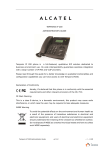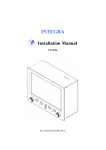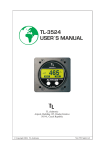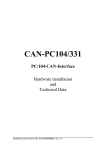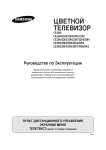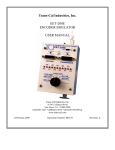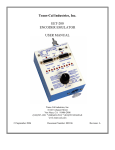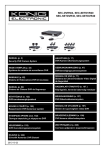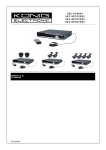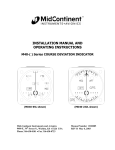Download UPS Aviation Technologies GX 65 Installation manual
Transcript
Trans-Cal Industries, Inc. Model SSD120-(XX)A & Model SSD120-(XX)AE All Solid State High Altitude Series 85,000 to 100,000 Feet Altitude Encoder/Digitizer Owner/Installation Manual T.S.O. C88a Approved Trans-Cal Industries, Inc. Van Nuys Airport 16141 Cohasset Street Van Nuys, CA 91406-2908 (818)787-1221 * (800)423-2913 * (818)787-8916FAX www.trans-cal.com 3 September 2004 Document Number: 881400-100 1 Revision: E This document may not be reproduced, transmitted, or copied in any form without the prior written consent of Trans-Cal Industries, Inc. The data contained herein is subject to change without notice. Please Note: It is the responsibility of the installer of this equipment, within a specific type or class of aircraft, to determine that the aircraft operating conditions are within TSO standards. Trans-Cal Industries, Inc. 16141 Cohasset Street Van Nuys, CA 91406 818/787-1221 800/423-2913 FAX 818/7878916 www.trans-cal.com History of Revision Revision Date Description 07/98 Production release. A 03/00 Added TDR950 & SL70 data Table IV. Changed Oper. Voltage +14 to +9 page 1. B 04/00 Added GTX327 Data Table II & GPS Connection Data. C 11/00 Added TxD2 data and rev. A outline drawing. D 12/00 Revised serial port data. E 9/04 Updated Manual. 2 Table of Contents Section 1.0 Introduction...................................................................................................... 4 1.1 Scope......................................................................................................................... 4 1.2 Equipment Description ............................................................................................. 4 1.3 General Specifications .............................................................................................. 4 1.3.1 Operating Altitude ............................................................................................. 5 1.3.2 Accuracy ............................................................................................................ 5 1.3.3 Serial Port Altitude Data Resolution.................................................................. 5 1.3.4 Mechanical Characteristics ................................................................................ 5 1.3.5 Environmental.................................................................................................... 6 1.3.6 Over Range ........................................................................................................ 6 1.4 Parallel Altitude Data Port Specifications ................................................................ 6 1.5 Serial Port Specifications.......................................................................................... 7 1.6 Serial Communication Format.................................................................................. 7 1.7 Serial Communication Protocol................................................................................ 8 Section 2.0 Operation.......................................................................................................... 9 2.1 General...................................................................................................................... 9 2.2 Operating Instructions............................................................................................... 9 Section 3.0 Installation and Calibration............................................................................ 10 3.1 Mechanical Installation........................................................................................... 10 3.2 Electrical Installation .............................................................................................. 10 3.3 Serial Altitude Data Port Test Equipment .............................................................. 11 Section 4.0 Calibration and Configuration ....................................................................... 12 4.1 Calibration Overview.............................................................................................. 12 4.2 Required Equipment Dynamic Calibration:............................................................ 12 4.3 Hyper Terminal Set-Up on the IBM Compatible PC.............................................. 13 4.4 Serial Port Software Configuration......................................................................... 14 4.5 Dynamic Calibration Adjustment Procedure .......................................................... 15 4.6 Configuration and Dynamic Calibration Command List........................................ 17 4.7 Error Correction Table............................................................................................ 18 4.8 Required Equipment Span Adjust: (See span adjust block drawing.) .................... 19 4.9 Span Adjust Procedure............................................................................................ 19 4.10 Span Adjust Command List .................................................................................. 23 Digitizer / Transponder Interconnections ......................................................................... 24 Temperature vs. Warm-up Time....................................................................................... 33 Span Adjust Block Diagram ............................................................................................. 34 Dynamic Calibration Block Diagram ............................................................................... 35 Wiring Harness Diagram .................................................................................................. 36 Outline Drawing................................................................................................................ 37 3 Section 1.0 Introduction 1.1 Scope This manual provides detailed installation, calibration and operating instructions for Trans-Cal Industries’ Model SSD120-(XX)A and SSD1201 (XX)AE series of high altitude (85,000 feet and above) encoder/digitizer. 1.2 Equipment Description Approved under F.A.A. TSO-C88a, the Model SSD120-(XX)A and SSD120-(XX)AE is an all solid state electronic device which when connected to an aircraft static and electrical system, converts pressure altitude information into parallel and serial digital data. The parallel digital altitude data protocol is set forth in the (ICAO) International Standard for SSR Pressure Altitude Transmission. In accordance with U.S. National Standards for Common System Component Characteristics for the I.F.F. Mark X (SIF)/Air Traffic Control Radar Beacon System SIF/ATCRBS. The serial altitude data is provided on (2) two asynchronous RS232 output ports. The serial data protocol is individually selectable for each port (refer to Table V & VI and Section 4.4) and may be used to provide pressure altitude data to GPS or other on board navigation devices. 1.3 General Specifications Operating Voltage: Model SSD120-(XX)A Model SSD120-(XX)AE 2 +9 to 30 VDC. +26 to 30 VDC. Operating Current: Model SSD120-(XX)A 0.1 Amps. Model SSD120-(XX)AE Model SSD120-(XX)AE 0.1 Amps. 0° to +70°C. 1.0 Amps. 0° to -55°C. Operating Temperature: Model SSD120-(XX)A -20° to +70°C. Model SSD120(XX)AE -55° to +70°C. Storage Temperature (non-operating) all models: -65°C to +85°C. Weight: 17 oz. 1 SSD120-(XX)AE Extended operating temperature range: -55°C to +70°C. 2 The low temperature heat circuit is designed to be operated at +28VDC, but the SSD120-(XX)AE model may be operated at +12VDC if the operating temperature does not fall below 0°C. 4 1.3.1 Operating Altitude Model SSD120-85A( ) -1000 to +85,000 feet. Model SSD120-100A( ) -1000 to +100,000 feet. 1.3.2 Accuracy Model SSD120-(XX)A: Accuracy throughout operating temperature range -20° to +70°C -1000 to +42,000 feet ±50 feet. +42,100 to +62,000 ±75 feet. +62,100 to maximum altitude ±125 feet. Model SSD120-(XX)AE Accuracy from -30° to +70°C: -1000 to +42,000 feet ±50 feet. +42,100 to +62,000 feet ±75 feet. +62,100 to maximum altitude ±125 feet. Accuracy from -55° to -31°C: -1000 to +42,000 feet ±75 feet. +42,000 to +62,000 feet ±125 feet. +62,100 to maximum altitude ±175 feet. Accuracy after 15 minute warm-up at -55°C: (See figure 1 for warm-up/start-up time.) -1000 to +42,000 feet ±50 feet. +42,100 to +62,000 feet ±75 feet. +62,100 to maximum altitude ±125 feet. 1.3.3 Serial Port Altitude Data Resolution The default resolution of the altitude digitizer serial data is 100 feet. To enable 10 foot resolution, connect pin 2 of the 9 pin D-Subminiature connector to ground (see Table V.) The serial port resolution may also be configured via software, see Section 4.4. 1.3.4 Mechanical Characteristics Model Number Model SSD120-85A( ) Model SSD120-100A( ) Dimensions See Outline Drawing See Outline Drawing 5 Weight 17 oz. 17 oz. 1.3.5 Environmental All model SSD120-(XX)A( ) digitizers have been designed, tested and approved under the requirements of TSO-C88a, in accordance with RTCA Document DO160b, dated July 1984 (specifics provided upon request.) 1.3.6 Over Range The SSD120-(XX)A( ) series of altitude digitizers will not be damaged when operated beyond their specified maximum altitude up to pure vacuum feet MSL, or over pressured to 18 psi max. 1.4 Parallel Altitude Data Port Specifications Code Format: In accordance with U.S. National Standard for Common System Component Characteristics for the IFF Mark X (SIF) Air Traffic Control Radar Beacon System, SIF/ATCRBS. Driver Description: The parallel altitude data output is provided by the “uncommitted” collectors of a transistor array and must be “pulled-up” through a resistive load by the transponder. Pull-Up Voltage: +3 to 50VDC. Maximum Sink Current: 25 milliamperes. Maximum Cable Length: 4000 feet.(1219 meters) Input Signal Requirement: Pin 6 (strobe or signal common) must be either grounded or connected to the transponder. 6 1.5 Serial Port Specifications Electrical Format: Conforming to the TIA/EIA RS-232E standard. Logic Levels: “0”, +9 volts. Logic “1”, -9 volts. Driver Output Maximum Voltage: ±25 VDC. Driver Load Impedance: 3KOhm typ. The TIA/EIA RS232E standard recommends one receiver per serial port. Maximum Cable Length: 50 Feet.(15.24 meters) Code Format: ASCII Communication System: Simplex (Talk Only). Transmission Method: Asynchronous. Transmission Rate: Selectable, 1200 bps to 9600 bps. Update Rate: 10/sec. 1.6 Serial Communication Format Model SSD120-(XX)A( ) carries out serial communication asynchronously with the “Start/Stop” system. The specifics of the format, i.e. the number of data bits, baud rate etc., is determined by the protocol selected. 7 1.7 Serial Communication Protocol (Refer to Table V & VI and Section 4.4) Protocol is user selectable by grounding or leaving open pin 6 or pin 7 of the 9 pin D-Subminiature connector, or by selecting protocols via software see Section 4.4. Note: The following hardware jumpers will override any software settings described in Section 4.4. Leaving pin 6 and 7 of the 9 pin connector open results in a protocol compatible with UPS Aviation Technologies’ (IIMorrow) Navigation devices. At a baud rate of 1200 bps the Digitizer sends a seventeen byte message beginning with # AL, then a space followed by five altitude bytes; the letter “T” and the number “25”; two checksum bytes and a carriage return. Examples of serial messages for (IIMorrow) devices: Message: Definition: #AL +00800T+25D8r Altitude 800 feet Grounding pin 7 of the 9 pin connector results in a protocol compatible with some navigation devices manufactured by Trimble and Garmin. At a baud rate of 9600 bps the Digitizer sends a ten byte message. The message begins with ALT followed by a space and five altitude bytes; concluding with a carriage return. Examples of serial messages for Trimble or Garmin devices: Message: ALT 99900 r ALT 10500 r Definition: Digitizer disabled. Altitude 10,500 feet. Grounding pin 6 of the 9 pin connector results in a protocol compatible with some navigation devices manufactured by Northstar and Garmin. At a baud rate of 2400 bps the Digitizer sends a 10 byte message. The message begins with ALT followed by a space and five altitude bytes; concluding with a carriage return. Examples of serial messages for these devices: Message Definition: ALT 02500 r Altitude 2500 feet. ALT -2500 r Digitizer disabled. Grounding both pins 6 and 7 of the 9 pin connector results in a protocol compatible with some navigation devices manufactured by Magellan. At a baud rate of 1200 bps the Digitizer sends a seventeen byte message beginning with $MGL, followed by a +/sign and five altitude digits, then T+25, a checksum and concludes with a carriage return. Examples of serial messages for Magellan devices: Message Definition: $MGL+02500T+25D6 r Altitude 2500 feet. 8 Section 2.0 Operation 2.1 General The SSD-120(XX)A( ) series of altitude digitizer’s are designed to be mounted within a pressurized or non-pressurized, but temperature controlled area within aircraft operating up to 100,000 feet MSL. Usually remotely located, the digitizer is fully automatic in operation. The parallel data output is controlled by the transponder while the serial altitude data is transmitted asynchronously. 2.2 Operating Instructions Parallel Data: Place the transponder in mode “C” altitude reporting mode, and apply power to the transponder and to the digitizer. In some installations the digitizer will automatically be supplied power when the transponder is energized; in others, power to the digitizer may be through a separate circuit breaker. If power to the digitizer is provided directly from the aircraft’s avionics buss, follow the power-up procedures recommended by the transponder manufacturer. Upon power-up the parallel data will assume the value for the present input pressure. In some installations, the transponder controls the digitizer by enabling and disabling its outputs. In other installations, the digitizer’s output is not controlled by the transponder and is continuously enabled, (Digitizer pin 6 is grounded.) Serial Data The serial communication is fully automatic and transmission begins after the self-test/warm-up is complete. Strobing the parallel data output of the digitizer will not affect the serial data transmission. 9 Section 3.0 Installation and Calibration 3.1 Mechanical Installation The SSD120(XX)A( ) series of digitizer may be mounted in any attitude within the internal structure of the aircraft. DO NOT mount the digitizer in the direct airstream of either hot or cold air ducts. The mounting position should allow for a short pressure line from the digitizer to the altimeter, access to the digitizer’s adjustments, and ample room for a service loop for the interconnecting cabling to the transponder. Use #4-40 machine screws, sheet metal screws, or pop rivets to attach the digitizer or the mounting tray to the airframe. Secure mating connectors to the digitizer housing using the #4-40 screws provided. Refer to the outline drawing for mechanical dimensions and the installation block diagram. 3.2 Electrical Installation The digitizer is designed to operate with either a 14 or 28 VDC power source. These voltages can be A+ switched power provided by the transponder or can be provided by the avionics buss. If using the avionics buss, protect the circuit with a fuse or circuit breaker. Parallel Data Connection The outline drawing provides electrical connector pin/function information. Use this data when connecting the digitizer to the transponder. In some installations where older transponders are used, the transponder may not provide an “altitude disable” function. In this case, an instrument panel mounted switch for this function may be required. Serial Data Connection (Table V lists the pin assignments for the serial port 3 connector.) Connect the TxD1 or TxD2 (transmit data) from the 9 pin DSubminiature connector to the RxD (receive data) port on the GPS or other navigation device. All grounds on the 9 pin D-subminiature connector are internally connected to ground and may be used to ground protocol pins, as well as provide data ground to the receiving GPS or other device. Pin 3 (RxD) of the 9 pin connector is used for calibration only. See Table V for connector pin assignments, Section 4.4 for software assigned protocols, and Section. 4.5 for calibration data. Shielded cable is recommended for both serial and parallel data wiring harnesses. 10 3.3 Serial Altitude Data Port Test Equipment The output of the serial port may, or may not be directly displayed by the GPS or other device receiving the serial data. There are several ways to test the output of the serial port: 1. Connect to an open serial port on a personal computer using serial data capture software such as PROCOMM™, VERSATERM™, SOFTWARE WEDGE™, TERMINAL (Windows® 3.x) or HYPERTERMINAL (Windows® 95 & 98). 2. Use a dedicated serial data test box such as the BLACK BOX™ RS232 Monitor. c) Test for a serial output using an oscilloscope to view the 9 VDC square wave transmitted about ten times a second. 3.4 Parallel Altitude Data Port Test Equipment The output of the parallel altitude data may be monitored by any number of transponder ramp test sets which allow display of the altitude digitizer/encoder code. Alternatively, the Trans-Cal Industries’ ATS-200 may be used to display the parallel data. The selected serial data protocol is transmitted simultaneously on both TxD1 and TxD2, unless assigned separately via Serial Port Software Configuration see Section 4.4 . 11 Section 4.0 Calibration and Configuration 4.1 Calibration Overview This procedure will allow adjustment to the calibration curve of the SSD120-(XX)A or SSD120-(XX)AE as an aide in matching the digitizer output to a primary flight altimeter or NIST traceable pressure standard. The maximum allowed error between the primary flight altimeter and the altitude digitizer is ±125 feet as required by TSO-C88a. All Trans-Cal digitizers are calibrated to NIST traceable pressure standards; however, the error allowed on altimeters at higher altitudes can lead to a combined error in excess of ±125 feet. This device may be adjusted utilizing an externally addressable EEPROM which is configured to accept an alternate altitude error curve entered to the digitizer via an IBM compatible PC. As an alternative to Dynamic Calibration the span of the transducer itself may be adjusted via the span adjust procedure. The technician may perform which ever procedure seems best suited for the application at hand. It is not required to perform both procedures. 4.2 Required Equipment Dynamic Calibration: (See dynamic calibration block diagram.) 1. Primary flight altimeter or NIST traceable pressure standard. 2. +12 to 28VDC power supply. 3. IBM compatible computer with an available serial port. 4. Software requirement: Windows 98® using Hyper Terminal Ver. 5.0 by Hilgraeve. (Available as a free download at http://www.hilgraeve.com) (Software Note: The Hyper Terminal program which is shipped with Windows 98® will not function correctly. You must download Version 5.0 or better, to calibrate this device.) 5. A pitot-static test set, capable of exercising the altimeter and digitizer over a range of -1000 feet to the maximum altitude of the digitizer. 6. Optional: ATS-200 or equal device which will allow the display of the 100 foot resolution parallel altitude data. 12 4.3 Hyper Terminal Set-Up on the IBM Compatible PC Boot up the computer and start the Hyper Terminal program. Hyper Terminal may be located in the Programs section or in the Accessories section under Communications . Under the New Connection window. (Identifies the new connection.) -Choose an icon then select an identifying title such as “Test.” Select OK after you have made your choices. Under the Connect to window (Selects the Com port to use.) Choose Connect Using Com 1 or whatever Com port you have chosen to use. After your selection click on OK. Under the Com ? Properties, (Sets communication properties.) Under the Port Settings tab, set the following: Bits per second: Data bits: Parity: Stop Bits: Flow Control: 9600 8 None 1 None Select OK In the Hyper Terminal window select File then click on Properties. Under the Com ? Properties window click on the Settings tab. Set the following: Function, arrow, ctrl keys to act as Terminal Keys. Emulation to Auto Detect Under ASCII Setup Set the following: Echo off. Wrap lines that exceed terminal width. Select OK. The software is now configured for operation. 13 4.4 Serial Port Software Configuration This device incorporates two separate RS232E compatible outputs which may be configured via software to transmit 2 different altitude data protocols simultaneously. Connect the digitizer to an IBM compatible computer running Hyperterminal as described in Section 4.3 and as shown in the Dynamic Calibration Block Diagram. Assign the serial port protocols as follows: Apply power to the digitizer and after the self test time has elapsed data will appear on the PC screen. Type <enter> The digitizer will respond with ?>(current altitude) Type ADJ <enter> Accesses the digitizer adjustment program. The Digitizer responds A= Type P <enter> To identify the current serial port settings. The digitizer will respond with a three digit number as follows: Serial Altitude Data Resolution TxD2 Protocol TxD1 Protocol 1. The first digit represents the serial altitude data resolution. 0= Use D-Sub connector protocol hardware jumpers. 1= 100 foot resolution on TxD1 and TxD2. 2= 10 foot resolution on TxD1 and TxD2. 2. The second digit represents the protocol selection for TxD1.0= Use D-Sub connector protocol hardware jumpers. 1= UPS Aviation Technologies. 1200bps. 2= Trimble/Garmin. 9600bps. 3= Northstar. 2400bps. 4= Magellan, 1200bps. 5= ARNAV, 9600bps. 3. The third digit represents the protocol selection for TxD2. 0= Use D-Sub connector protocol hardware jumpers. 1= UPS Aviation Technologies. 1200bps. 2= Trimble/Garmin. 9600bps. 3= Northstar. 2400bps. 4= Magellan, 1200bps. 5= ARNAV, 9600bps. Example: Type P212<enter> Defined as 10 foot resolution on TxD1 and TxD2. UPS Aviation Technologies protocol transmitted on TxD1. Trimble/Garmin protocol transmitted on TxD2. 14 4.5 Dynamic Calibration Adjustment Procedure 1. Construct a wiring harness per the wiring harness diagram. (This harness may be ordereddirectly from Trans-Cal Industries. Please specify 9 pin or 25 pin connector. Request P/N: 881404.) 2. Connect the digitizer, computer and altimeter as shown in the test setup diagram, andenergize. 3. Open the Hyper Terminal program as described in Section 4.5. 4. The digitizer output should now be displayed on the PC screen with 10 foot resolution.(You may use the Hyper Terminal “Clear Screen” function to remove any extra characters that may be cluttering the screen. Click on Edit then click on Clear Screen.) Note: Backspace does not function in Hyper Terminal. If a typing error occurs, hit <enter> and begin again. 5. Set the altimeter barometric input to 29.92 In. Hg. Change the input pressure to -1000 feet and begin to compare the altitude digitizer output, as displayed on the computer, to the altimeter reading at every 1000 foot mark. When the digitizer output begins to differ from the altimeter by more than ±30 feet begin to change the digitizer error curve. (Section 4.9 provides a table to give the technician a record of changes required and implemented.) (Note: no digitizer correction is possible at the -1000 foot mark.) 6. Type <enter> the Digitizer will respond with ?>(current altitude) 7. Type ADJ <enter> The computer will respond with A= CAUTION: Always refer to the altimeter and VSI manufacturer’s data for maximum rate of climb or descent and any special test conditions which must be complied with. 8. Adjust the input pressure until the altimeter is exactly reading a 1000 foot mark. Note thedifference between the digitizer and the altimeter and adjust as required. Example: The altimeter reads 10,000 and the digitizer reads 10,080. Type “S10 <enter>” (S10 represents Set 10,000feet) The digitizer will now output 10,000 feet based on the current input pressure. The PC will display the altitude at which the digitizer will make this change. In the example above the PC would display >10000. 9. Proceed to the next 1000 foot mark and repeat the procedure, as in step 8 above, until the entire operating range of the digitizer is completed. 15 4.5 Dynamic Calibration Adjustment Procedure(continued) (Note: If no correction is required at an altitude simply do not enter a correction. The technician does not have to enter 000.) You may quit the adjustment program at any time by typing “Q” twice, the digitizer output will then be displayed on the PC screen. 10. After completing the above procedure you may examine the corrections entered into theEEPROM. Type “D<enter>” to dump the EEPROM data and read the current error curve on the PC screen. The following table should appear: 00= 000 06= 000 12= 000 18= 000 24= 000 30= 000 36= 000 42= 000 48= 000 54= 000 60= 000 66= 000 71= 000 77= 000 83= 000 89= 000 95= 000 >current altitude 01= 000 07= 000 13= 000 19= 000 25= 000 31= 000 37= 000 43= 000 49= 000 55= 000 61= 000 66= 000 72= 000 78= 000 84= 000 90= 000 96= 000 02= 000 08= 000 14= 000 20= 000 26= 000 32= 000 38= 000 44= 000 50= 000 56= 000 62= 000 67= 000 73= 000 79= 000 85= 000 91= 000 97= 000 03= 000 09= 000 15= 000 21= 000 27= 000 33= 000 39= 000 45= 000 51= 000 57= 000 63= 000 68= 000 74= 000 80= 000 86= 000 92= 000 98= 000 04= 000 10=-080 16= 000 22= 000 28= 000 34= 000 40= 000 46= 000 52= 000 58= 000 64= 000 69= 000 75= 000 81= 000 87= 000 93= 000 99= 000 05= 000 11=000 17= 000 23= 000 29= 000 35= 000 41= 000 47= 000 53= 000 59= 000 65= 000 70= 000 76= 000 82= 000 88= 000 94= 000 The first two digits represent altitude x1000 feet and the last three digits after the equal sign represent the amount of error introduced at the altitude in feet. 16 4.6 Configuration and Dynamic Calibration Command List Following is a list of commands which will operate in the ADJ mode using Hyper Terminal. Top Level Menu: ADJ <enter> Enter Adjustment mode. Q <enter> Quit and return to operate mode. Sub-Menu CLR <enter> Clear all EEPROM data. D <enter> Dump to list all EEPROM data. P <enter> Displays current serial Port settings, see Section 4.6 Serial Port Software Configuration. Pabc<enter> Port protocol select, see Section 4.6 Serial Port Software Configuration. Q<enter> Quit and return to top level menu. Saa<enter> Set digitizer to 1K altitude (aa) mark at current input pressure. NOTES: 1. Backspace does not function. If a typing error occurs hit <enter> and begin again. 2. 1K altitude values 90 to 99 in EEPROM contain factory calibration data and are not customer accessible. 3. A maximum error of ±499 feet may be introduced at any one altitude. 4. CLR clears all error data in the EEPROM. 5. ERR indicates syntax error. 17 4.7 Error Correction Table Altitude Correction Altitude Correction Altitude Correction Altitude -1000 25000 51000 77000 0 26000 52000 78000 1000 27000 53000 79000 2000 28000 54000 80000 3000 29000 55000 81000 4000 30000 56000 82000 5000 31000 57000 83000 6000 32000 58000 84000 7000 33000 59000 85000 8000 34000 60000 86000 9000 35000 61000 87000 10000 36000 62000 88000 11000 37000 63000 89000 12000 38000 64000 90000 13000 39000 65000 91000 14000 40000 66000 92000 15000 41000 67000 93000 16000 42000 68000 94000 17000 43000 69000 95000 18000 44000 70000 96000 19000 45000 71000 97000 20000 46000 72000 98000 21000 47000 73000 99000 22000 48000 74000 23000 49000 75000 24000 50000 76000 18 Correction 4.8 Required Equipment Span Adjust: (See span adjust block drawing.) 1. NIST traceable pressure standard. Accuracy better than 0.05% FS is required, 0 to 15 psi. 2. +28VDC power supply. 3. IBM compatible computer with an available serial port. Software requirement: Windows 98® using Hyper Terminal Ver. 5.0 by Hilgraeve. (Available as a free download at http://www.hilgraeve.com)(Software Note: The Hyper Terminal program which is shipped with Windows 98® will not function correctly. You must download version 5.0 or better to use this calibration program.) 4. Digitizer/PC interface cable. (See wiring harness diagram or special order from Trans-Cal.) 5. Vacuum and pressure source and control capable of exercising the digitizer/pressure standard over the digitizer’s operating range. (Note: The static system needs to be very stable or nearly leak free.) (Optional: ATS-200 or equal device which will allow the display of the parallel 100 foot altitude data.) 4.9 Span Adjust Procedure 1. Construct a wiring harness per the wiring harness diagram. 2. Connect the digitizer and computer as shown in the span adjust test set-up diagram, andenergize. 3. Open and configure the Hyper Terminal program as described in Section 4.3. 4. The digitizer output should now be displayed on the PC screen with 10 foot resolution.(You may use the Hyper Terminal “Clear Screen” function to remove any extra characters that may be cluttering the screen. Click on Edit then click on Clear Screen.) 5. Adjust input pressure until the pressure standard reads the maximum operating altitude of the Note: Backspace does not function in Hyper Terminal. If a typing error occurs, hit <return> and begin again. digitizer. SSD120-50A(E) 50,000 feet 3.4247 In.Hg. SSD120-62A(E) 62,000 feet 1.9237 In.Hg SSD120-65A(E) 65,000 feet 1.6654 In.Hg. SSD120-80A(E) 80,000 feet 0.8155 In. Hg. 19 4.9 Span Adjust Procedure(continued) 6. Note the digitizer pressure as displayed on the Hyper Terminal. Calculate the digitizer error: Example: The pressure standard reads 62,000 and the digitizer serial output on the PC reads: ALT 61,910 Error = (61910 - 62000= -90) Adjust the Z parameter to correct this error. Each number added or subtracted from the Z parameter results in an approximate 10' correction at 62,000 feet. Note: If the digitizer reads low in relation to the manometer, as in the case above, then a negative correction is required. In the above case a command of *00Z= -9<return> would yield approximately a 90 foot change. Note: If the digitizer transition is high in relation to the manometer reading then a positive correction is applied. 7. Access the adjustment feature and read the current Z parameter value: Type <enter>, until the digitizer returns a ? along with the current pressure. Type XD <enter> to enter the Span Adjust mode. Type *00Z= <enter> The digitizer will return the current Z parameter value. Note: The Z parameter is set at the factory when compared to a NIST traceable pressure standard. Write down the current factory value before proceeding so that you may return to the original factory setting, if required. 8. Change the Z parameter value as required:Type *00WE <enter> to write enable the EEPROM. Type *00Z=N<enter> Where N represents a number to correct the digitizer Z parameter. (No sign required for a positive value.) The factory error must be taken into account when changing any parameter. Example: 20 4.9 Span Adjust Procedure(continued) (You may use the Hyper Terminal “Clear Screen” function to remove any extra characters that may be cluttering the screen. Click on Edit then click on Clear Screen.) Compare the digitizer altitude data to the pressure standard at 62,000 feet. If further adjustments are required, repeat the Z parameter correction as above. 9. If the digitizer is within ±20 feet of the pressure standard at the digitizer maximum operating altitude, adjust the input pressure to 1000 feet or 28.8557 In. Hg. 10. Note the digitizer pressure as displayed on the Hyper Terminal. Calculate the digitizer error at 1000 feet: Example: the pressure standard reads 1,000 and the digitizer serial output on the PC reads: ALT 990 Error = (990 - 1000= -10) Adjust the X parameter to correct this error. Each number added or subtracted from the X parameter results in an approximate 1' correction at 1,000 feet. Note: If the digitizer reads low in relation to the manometer, as in the case above, then a negative correction is required. In the above case a command of *00X= -10<return> would yield approximately a 10 foot change. Note: If the digitizer transition is high in relation to the manometer reading then a positive correction is applied. 11. Access the adjustment feature and read the current X parameter value: Type <enter>, until the digitizer returns a ? along with the current pressure. Type XD <enter> to enter the transducer Span Adjust mode. Type *00X= <enter> The digitizer will return the current X parameter value. Note: The X parameter is set at the factory when compared to a NIST traceable pressure standard. Write down the current factory value before proceeding so that you may return to the original factory setting, if required. 12. Change the X parameter value as required: 2 Type *00WE <enter> to write enable the E PROM. 21 4.9 Span Adjust Procedure(continued) Type *00X=N<enter> Where N represents a number to correct the digitizer X parameter. (No sign required for a positive value.) The factory error must be algebraically added to the new required error, when changing any parameter. Example: Type Q to quit the adjustment program and return to read the current input pressure. Note: You may use the Hyper Terminal “Clear Screen” function to remove any extra characters that may be cluttering the screen. Click on Edit then click on Clear Screen. Compare the digitizer altitude data to the pressure standard at 1,000 feet. If further adjustments are required, repeat the X parameter correction as above. 13. The X and Z parameter adjustments do slightly affect one another. Adjust the input pressure until the pressure standard reads the maximum digitizer operating altitude and compare the digitizer output, as displayed on the PC, to the pressure standard. If an adjustment is required, return to the Z parameter and repeat steps 5 thru 12. 14. After verifing the calibration is correct at 1000 feet and the maximum altitude, store yourchanges in the transducer memory. Type *00WE <enter> to write enable the EEPROM. Type *00SP=ALL<enter> to store all current parameters. 22 4.10 Span Adjust Command List Following is a list of commands which will operate in the Span Adjust mode. Top Level Menu XD <return> Access transducer span adjustment mode. Q<enter> Quit and return to operate mode. Sub-Menu Command Definition *00WE<enter> Write enable the EEPROM. *00Z=<enter> Returns the current Z parameter value Set this value at the maximum operating altitude of the digitizer. *00Z=N<enter> “N” defines a number between 0 and 50 or 0 and -50 which will affect a change in the Z parameter of the transducer. (No sign is required for a positive number.) Example: *00Z=5<enter> *00X=<enter> Returns the current X parameter value *00X=N<enter> “N” defines a number between 0 and 100 or 0 and 100 which will affect a change in the reference span of the transducer. (No sign is required for a positive number.) Example: *00X=5<enter> *00SP=ALL<enter> Stores the all current parameter settings. Q Quit adjustment program and return to top level menu. 23 Digitizer / Transponder Interconnections The following digitizer/transponder interconnections are provided as a quick reference only, and though they are correct to the best of our knowledge, always consult the latest installation, operation, and service bulletins from the transponder manufacturer. Table I Function KT76/78 Pin SSD120 King KT76A/78A Pin 15 Pin King KXP Pin Number Conn. Number Number 1 D4 *4 *4 V 2 A1 6 M G 3 A2 7 K H 4 A4 9 J J 5 B1 4 E K 9 B2 1 C L 10 B4 2 B M 11 C1 3 D P 13 C2 8 L R 12 C4 10 H S 6 Output Enable 8 or 14 to 14 28VDC *5 Input. 15 Ground Connect to aircraft ground. Connect to aircraft ground. Connect to aircraft ground. Connect to Connect to aircraft’s avionics buss protected aircraft’s avionics by buss protected by a fuse or circuit breaker. a fuse or circuit breaker. Connect to Connect to aircraft aircraft ground. ground. *4 Data for this connection not available at this time. *5 Pins 8 and 14 are connected internally. 24 Connect to aircraft’s avionics buss protected by a fuse or circuit breaker. Connect to aircraft ground. Table II SSD120 15 Pin Conn. Function Cessna RT359A, RT459A, RT859A Narco AT-150 AT-50, AT-50A Pin Number Narco AT-6A AT-5, AT-6 Pin Number Garmin GTX 327 Pin Number Pin Number 1 D4 10 *6 *6 18 2 A1 14 7 2 3 3 A2 13 6 4 5 4 A4 15 8 8 6 5 B1 19 12 9 9 9 B2 17 10 10 11 10 B4 16 9 11 12 11 C1 21 14 1 10 13 C2 18 11 3 4 12 C4 20 13 5 7 6 Output Enable 11 5 12 13 or 25 or aircraft ground 14 to 28VDC Input 9 18 13 14 to 28VDC Input 14 Connect to aircraft ground. 8 or 14 *7 15 Ground Connect to aircraft ground. Connect to aircraft ground. *6 Data for this connection not available at this time. *7 Pins 8 and 14 are connected internally. 25 Serial Data Connection for the Garmin GTX327 Transponder SSD120-(XX)A 9 Pin Conn. Function GTX 327 25 Pin Conn. 4 or 9 TxD to RxD 19 1 or 5 or 8 Ground 13 or 25 Protocol, Connect pin 7 to ground. To allow the Garmin GTX 327 transponder to communicate with the SSD120-(XX)A go to the Setup Page and set the Altitude Source (ALT SRC) to receive data in the Icarus RS232 format. 26 Table III SSD120 Function Edo-Air Genave Collins Radair RT-777 Pin Number Beta 5000 Pin Number TDR 950 Pin Number 250 Pin Number 15 Pin Conn. 1 D4 15 0 3 15 2 A1 7 4 12 7 3 A2 5 5 10 6 4 A4 3 6 7 13 5 B1 12 7 6 9 9 B2 13 8 5 10 10 B4 14 9 4 11 11 C1 8 10 8 14 13 C2 6 11 11 16 12 C4 4 12 9 12 2 3 Connect to aircraft’s avionics buss protected by a fuse or circuit breaker. 2 2 Connect to 6 Output Enable 8 or 14 to 14 28VDC *8 Input 15 Ground Connect to aircraft ground. Connect to 19 22 aircraft’s avionics buss protected by a fuse or circuit breaker. aircraft ground. *8 Pins 8 and 14 are connected together internally. 27 Connect to aircraft ground. Connect to aircraft ground. Function Bendix TPR-2060 Pin Number Table IV Bendix TR641A/B Pin Number 1 D4 *9 N C 35 2 A1 4 A k 13 3 A2 6 B c 31 4 A4 8 C W 12 5 B1 9 D T 33 9 B2 10 E L 14 10 B4 11 F D 32 11 C1 3 H P 16 13 C2 5 J f 34 12 C4 7 K Z 15 6 Output Enable SSD120 15 pin Conn. Connect to aircraft ground. Connect to aircraft ground. Connect to Wilcox 1014A Pin Number UPS AT Apollo SL70 Pin Number Connect to aircraft ground. Connect to Connect to aircraft ground. Connect to Connect to aircraft’s avionics aircraft’s avionics aircraft’s avionics aircraft’s avionics *10 14 to 28VDC Input buss protected by a fuse or circuit breaker. buss protected by a fuse or circuit breaker. buss protected by a fuse or circuit breaker. buss protected by a fuse or circuit breaker. 15 Ground Connect to aircraft Connect to Connect to aircraft Connect to aircraft 8 or 14 ground. aircraft ground. ground. ground. Serial Altitude Data Connection for the Apollo SL70 Transponder SSD120-(XX)A 9 Pin Conn. Function UPS AT SL70 4 or 9 TxD to RxD 4 1 or 5 or 8 Ground 3 To allow the UPS AT SL70 transponder to accept serial data from the SSD120-(XX)A go to the Test Mode on the SL79 Conf page and set the Altitude Source (ASrc) to receive Serial (Ser) data. On the BAUD page select 1200. *9 Data for this connection not available at this time. *10 Pins 8 and 14 are connected internally. 28 Table V Serial Port Connector, 9 Pin D-Subminiature DE-9S Pin Function 1 Ground *11 2 Ground for 10' resolution. 3 RxD 4 TxD1 *12 5 Ground *11 6 Protocol select, see function Table VI below. 7 Protocol select, see function Table VI below. 8 Ground *11 9 TxD2 *12 Table VI Protocol Selection: DE-9S D-Subminiature Connector Function Table Protocol Selection Pin Pin Pin 2 6 7 UPS AT 100' resolution, 1200bps. UPS AT 10' resolution, 1200bps. Open Gnd. Open Open Open Open Trimble/Garmin, 100' resolution, 9600bps. Trimble/Garmin, 10' resolution, 9600bps. Open Gnd. Open Open Gnd. Gnd. Northstar/Garmin, 100' resolution, 2400bps. Northstar/Garmin, 10' resolution, 2400bps. Open Gnd. Gnd. Gnd. Open Open Magellan, 100' resolution, 1200bps. Magellan, 10' resolution, 1200bps. Open Gnd. Gnd. Gnd. Gnd. Gnd. *11 *12 Pins 1 and 5 and 8 are internal grounds provided for protocol selection and serial data ground. TxD1 and TxD2 are two (2) separate RS232 outputs which will transmit the protocol selected by grounding the pins above, or will transmit separate protocols as assigned via software, see Section 4.4 Serial Port Software Configuration. Note: The hardware jumpers override any software serial port settings. 29 GPS Connection Data Given the speed with which new GPS units are entering the market, it is impossible to provide data on every device. The following digitizer/GPS interconnections are provided as a quick reference only, and though they are correct to the best of our knowledge, always consult the latest installation, operation, and service bulletins from the GPS manufacturer. UPS Aviation Technologies (IIMorrow) Apollo Model GX50, GX60, GX65 Apollo GX50, GX60, GX65 Signal Apollo 37 Pin D-Sub Connector SSD120-(XX)A 9 Pin DSubConnector RxD2 21 4 or 9 Ground 20 1 or 5 or 8 Optional, jumper pin 2 to ground for 10' resolution. Apollo GX50, GX60, GX65 Software Configuration In test mode, rotate the Large knob to select serial port configuration RX. Press SEL, rotate the large knob to select the RxD2 port, rotate the small knob to select AltEnc input. Apollo Model MX20 Multi Function Display Apollo MX20 Signal Apollo 37 Pin D-Sub Connector SSD120-(XX)A 9 Pin DSubConnector RxD2 21 4 or 9 Ground 3 1 or 5 or 8 Optional, jumper pin 2 to ground for 10' resolution. Apollo MX20 Software Configuration Under External Data Source set altitude source to Port 2. 30 Trimble Trimble 2101 Approach Plus GPS Receiver Trimble Signal Trimble 2101 Port 1 Trimble 2101 Port 2 SSD120-(XX)A 9 Pin D-Sub Connector Pin RxD+ 7 24 1 or 5 RxD 8 36 4 or 9 Ground 3 or 20 3 or 20 1 or 5 Protocol assignment, jumper pin 7 to ground on pins 1 or 5 or 8 Optional, jumper pin 2 to ground for 10' resolution. Trimble 2101 Approach Plus GPS Receiver Software Configuration - Installation Setup Access the 2101 installation setup submenu and go to the SERIAL I/O SETUP. Select the GPS serial port which is to receive the pressure altitude data, SERIAL1 IN or SERIAL-2 IN. Set data format to ENCODER. Trimble Signal 2101 I/O Approach Plus GPS Receiver SSD120-(XX)A 9 Pin D-Sub Trimble 2101 Trimble 2101 Connector Pin I/O Serial I/O Serial Port Port 1 2 RxD+ J1-7 J1-24 1 or 5 RxD- J1-8 J1-36 4 or 9 Ground J1 - 3 or 20 J1 - 3 or 20 1 or 5 Protocol assignment, jumper pin 7 to ground on pins 1 or 5 or 8 Optional, jumper pin 2 to ground for 10' resolution. 2101 I/O Approach Plus GPS Receiver Software Configuration - Installation Setup Access the 2101 installation setup submenu and go to the SERIAL I/O SETUP. Select the GPS serial port which is to receive the pressure altitude data, SERIAL-1 IN or SERIAL2 IN. Set data format to ENCODER. 31 Garmin International Garmin 400 Series GPS Devices Garmin 78 Pin Conn. (P4001) Function SSD120-(XX)A 9 Pin Conn. 57 TxD 4 or 9 77 or 78 Ground 1 or 5 Protocol, jumper pin 7 to ground. Optional, jumper pin 2 to ground for 10' resolution. Garmin 400 series GPS software configuration To allow the Garmin 400 series GPS to communicate with the SSD120-(XX)A go to the Main RS232 Config page and set channel 1 input to Icarus-alt. 32 Temperature vs. Warm-up Time 33 Span Adjust Block Diagram 34 Dynamic Calibration Block Diagram 35 Wiring Harness Diagram 36 Outline Drawing 37 Trans-Cal Industries, Inc. Solid State Altitude Digitizer Part Number Ordering Information SSD120-XX X X-XXXX Max. Operating Altitude (Feet) 30,000 35,000 42,000 50,000 62,000 65,000 80,000 85,000 100,000 -30 -35 -42 -50 -62 -65 -80 -85 -100 Model Nomenclature Identifier Encoder / Digitizer Modular Encoder Servo Module A M SM Operating Temperature Range Blank E -20 to +70 C -55 to +70 C Additional Ports and Features -RS232 -RS -RS1 Dual RS232 Ports RS485 and Dual RS232 Ports RS485 and 1' Resolution on TxD2 Part Number Example: SSD120-42AE-RS232 Note: On models operating at 50,000 to 100,000 feet, dual RS232 ports are included as a standard feature. 38 WARRANTY REGISTRATION Trans-Cal Industries warrants each Model SSD120-(XX)A(E)-RS1 Solid State digitizer / serializer to be free of defects in workmanship and materials for a period of eighteen (18) months after purchase. This warranty applies to the original purchaser of the instrument. Trans-Cal’s obligation under this warranty is limited to repairing or replacing any unit returned to Trans-Cal during the life of this warranty provided: (1) The defective unit is returned to us, transportation pre-paid. (2) Prior approval is obtained from Trans-Cal. (3) The unit has not been damaged by misuse, neglect, improper operation, accident alteration or improper installation. Trans-Cal DOES NOT reimburse labor costs on warranty repairs. Trans-Cal Industries will be the sole judge as to the cause of the malfunction and wherein the responsibility lies. No other obligation or liability is expressed or implied. For the above warranty to become effective, the attached registration card must be completed and returned to Trans-Cal Industries, properly filled out and signed by the dealer selling or installing this equipment. Mail to: Trans-Cal Ind., Inc., 16141 Cohasset St., Van Nuys, CA 91406 - - - - - - - - - - - - - - - - - - - - - - - - cut here - - - - - - - - - - - - - - - - - - - - - - - - - MODEL: SSD120-( )A(E)-RS1 SERIAL NO: RS-_____________ AIRCRAFT:______________________ NUMBER:_____________________ OWNER:______________________________________________________ ADDRESS:____________________________________________________ CITY:_____________________________ STATE:______ZIP:___________ DEALER:_____________________________________________________ INSTALLED BY:_______________________________________________ LICENSE NO:_________________________________________________ INSTALLATION DATE:__________________________________________ I hereby certify the above instrument was installed in accordance with the instructions of Trans-Cal Industries, and the installation was done to industry standards. I further certify the instrument was properly working on the above date. SIGNED:____________________________________________________ PRINT NAME:________________________________________________ 39







































